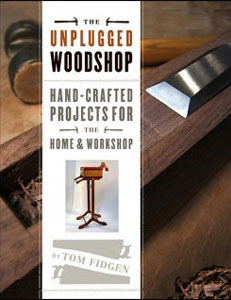
|
Amid the current flurry of excellent books on hand tool woodworking, it is hard to say that one or the other stands out from the rest. And yet, as I see it, this one by Canadian woodworker Tom Fidgen does. The successor to Fidgen's earlier hand tool–oriented book,
Made by Hand
, this one is more than merely well–written, which it is, and beautifully illustrated in color, which it also is.
The Unplugged Woodshop
is a stimulating source of ideas and techniques that will help any woodworker build her or his hand tool skills, all the while creating beautiful and useful projects for the home and woodshop.
Fidgen's 13 chapters present well over a baker's dozen projects in easy–to–follow form. Each is clearly described step–by–step and accompanied by cut lists and diagrams. Each project introduces new skills, tools or techniques and succeeding projects make use of them. Thus, Fidgen presents more than a collection of interesting projects; he also offers a course in building hand tool skills. If you build every project in this book, you'll end up quite capable of building virtually anything by hand alone. If you build only some of the projects, you'll have fun, learn a lot and come away with some interesting projects. Even if you only read the book without building anything Fidgen offers, you'll have an enjoyable time while learning about tools and techniques that may be unfamiliar and absorbing the benefit of Fidgen's many insightful tips.
Fidgen starts with the basics, dimensioning rough stock by squaring six sides of a board by hand. And he offers advice on glues–he prefers
hide glue
–and finishing–his choice is an oil finish and
shellac mixed from flakes
.
The first constructed project is a sawyer's bench, an essential shop tool for breaking down larger boards into those that will actually be used in projects. Fidgen's has one splayed leg, the other straight to accommodate ripping, with a ripping notch down the center for narrow stock and a bird's mouth at one end. An innovation is a removable fence on one side of the bench to steady wider boards. Building the bench will give you practice in cutting half laps, chiseling notches, rounding sharp corners and doweling joints.
The sawyer's bench comes in handy for the next project, a funeral chair–a folding chair that has many uses in the home, as auxiliary seating, for instance. You'll learn to make bridle joints in building these. To aid in their construction, Fidgen uses elevated bench dogs for rounding parts and he shows how you can build a set for yourself.
An architect's table follows. This table, essentially a drafting table, involves beveled joints and Fidgen introduces the
bevel gauge
as a valuable tool for laying out the parts accurately and without measurement. Other tools introduced are
chisels
,
spokeshaves
and
card scrapers
. Like many of his projects, Fidgen pre–finishes the parts of the table before final glue–up.
The next project, a lying press, is perhaps better known among woodworkers as a
Moxon Vise
. Building it teaches how to make wooden screws as well as drilling. Fidgen angles the handles on his vise to save his knuckles and adds a large chamfer on the front of the vise to ease cutting half blind dovetails.
One of the more interesting projects in the book is a pochade box, essentially an artist's sketch box, one that Fidgen keeps by his workbench to record and illustrate project plans and ideas. The box features an easel and a pencil drawer and is easily portable with the addition of a leather strap. In building this project you'll use a Plow Plane and a
side rabbet plane
to cut the joinery.
Several projects feature building
hand planes
. Fidgen shows how to build a razee style jack plane and a high angle smoothing plane, the razee style incorporating a cut down rear with a tote handle attached. Following that, he shows how to build a kerfing plane, used to accurately start resawing for veneer. While Fidgen's plane is set to cut at 1/8", he shows how you can make an adjustable fence version to create other thicknesses. To make use of the kerfing plane, Fidgen then shows how to build a
frame saw
you can use to cut your own
veneer
by hand.
The final three projects make use of the tools and techniques learned so far and result in some beautiful and exciting projects. The Good Doctor's Medicine Chest will probably never be used to carry potions and snake oil as in the olden days, but this four compartment box will be good to tote a supply of wine or store jewelry. The Gentleman's Valet uses many of the techniques demonstrated earlier and features veneering. The Card Catalog will likely never hold 3x5 cards, but with its variably–sized drawers it can be employed as a hall table, in the kitchen or in a variety of other places where it will be both functional and a point of particular interest.
The Unplugged Woodshop
is a great resource and learning opportunity for any woodworker who is beginning or continuing the hand tool journey. More advanced hand tool woodworkers will find the project ideas stimulating and educational. And all woodworkers will find this book to be a fun read. I enjoyed it a lot and plan to use many of the techniques Fidgen teaches in my own work. I think you'll like the book as well.
Find out more and purchase
The Unplugged Woodshop
J. Norman Reid is a woodworker, writer, and woodworking instructor living in the Blue Ridge Mountains with his wife, a woodshop full of power and hand tools and four cats who think they are cabinetmaker's assistants. He is the author of
Choosing and Using Handplanes
.
He can be reached by email at
nreid@fcc.net
.
Return to the
Wood News Online
front page
|